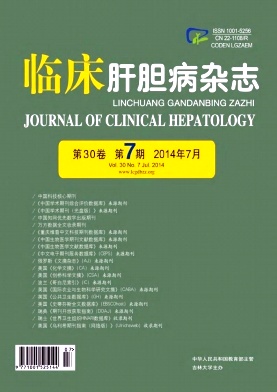|
[1]GARCEA G, MADDERN GJ.Liver failure after major hepatic resection[J].J Hepatobiliary Pancreat Surg, 2009, 16 (2) :145-155.
|
|
[2]ANSELMO A, ROSSI P, DE MAYO A, et al.Radiofrequencyassisted right hemihepatectomy by using a new incremental bipolar generator combined with liver hanging maneuver[J].Minerva Chir, 2011, 66 (5) :495-499.
|
|
[3]JING X, CHEN MH.Prevention and treatment of major complications in liver cancer patients after thermal ablation[J].J Clin Hepatol, 2013, 29 (8) :564-566. (in Chinese) 经翔, 陈敏华.热消融治疗肝癌术后严重并发症的预防及处理[J].临床肝胆病杂志, 2013, 29 (8) :564-566.
|
|
[4]CHEN XT, ZHAI J, ZHANGYJ, et al.The risk factors of posthepatectomy liver failure for hepatocellular carcinoma in patients of Child-Pugh A[J].J Hepatobiliary Surg, 2012, 20 (3) :170-173. (in Chinese) 陈绪涛, 翟健, 张一军, 等.Child-Pugh A级肝细胞癌患者术后肝功能衰竭发生的危险因素分析[J].肝胆外科杂志, 2012, 20 (3) :170-173.
|
|
[5]DING YT, JIANG CP.Liver failure after partial hepatic resection:pathophysiology, risk factors and treatment[J].Chin J Hepatobiliary Surg, 2011, 17 (4) :279-282. (in Chinese) 丁义涛, 江春平.肝切除术后肝功能衰竭:病理生理、危险因素与临床治疗[J].中华肝胆外科杂志, 2011, 17 (4) :279-282.
|
|
[6]YILDIRIM IO, SALIHOGLU Z, BOLAYIRLI MI, et al.Prospective evaluation of the factors effective on morbidity and mortality of the patients having liver resection surgeries[J].Hepatogastroenterology, 2012, 59 (118) :1928-1932.
|
|
[7]WU XQ, WAN H.Cause of liver failure and impact analysis of prognostic risk factors[J].J Clin Hepatol, 2013, 29 (4) :294-296. (in Chinese) 吴晓庆, 万红.肝衰竭预后的危险因素分析[J].临床肝胆病杂志, 2013, 29 (4) :294-296.
|
|
[8]POLSON J, LEE WM;American Association for the Study of Liver Disease.AASLD position paper:the management of acute liver failure[J].Hepatology, 2005, 41 (5) :1179-1197.
|
|
[9]GREENBERGER NJ.History taking and physical examination in pationts with liver disease[M]//SCHIFF ER.Schiff hepatology.9th Edition.Beijing:Chemical Industry Press, 2006:12.Greenberger NJ.肝病患者的病史采集和身体检查[M]//Schiff ER.希夫肝脏病学.9版.北京:化学工业出版社, 2006:12.
|
|
[10]PANIS Y, MCMULLAN DM, EMOND JC.Progressive necrosis after hepatectomy and the pathophysiology of liver failure after massive resection[J].Surgery, 1997, 121 (2) :142-149.
|
|
[11]FILOS KS, KIRKILESIS I, SPILIOPOULOU I, et al.Bacterial translocation, endotoxaemia and apoptosis following Pringle manoeuvre in rats[J].Injury, 2004, 35 (1) :35-43.
|













 DownLoad:
DownLoad: